Related Research Articles

The Dayak or Dyak or Dayuh are one of the native groups of Borneo. It is a loose term for over 200 riverine and hill-dwelling ethnic groups, located principally in the central and southern interior of Borneo, each with its own dialect, customs, laws, territory, and culture, although common distinguishing traits are readily identifiable. The Dayak were animist in belief; however, since the 19th century there has been mass conversion to Christianity as well as Islam due to the spreading of Abrahamic religions.
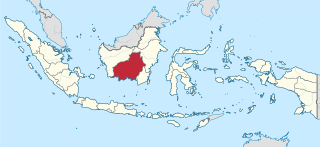
Central Kalimantan is a province of Indonesia. It is one of five provinces in Kalimantan, the Indonesian part of Borneo. It is bordered by West Kalimantan to the west, South Kalimantan and East Kalimantan to the east, Java Sea to the south and is separated narrowly from North Kalimantan and Malaysia by East Kalimantan's Mahakam Ulu Regency. Its provincial capital is Palangka Raya and in 2010 its population was over 2.2 million, while the 2020 Census showed a total of almost 2.67 million; the official estimate as at mid 2023 was 2,774,747.

The transmigration program was an initiative of the Dutch colonial government and later continued by the Indonesian government to move landless people from densely populated areas of Indonesia to less populous areas of the country. This involved moving people permanently from the island of Java, but also to a lesser extent from Bali and Madura to less densely populated areas including Kalimantan, Sumatra, Sulawesi, Maluku and Papua. The program is currently coordinated by Ministry of Villages, Development of Disadvantaged Regions, and Transmigration.

Baduy people are an indigenous Sundanese ethnic group native to the southeastern part of Banten, specifically Lebak Regency, Banten, Indonesia.

Bidayuh is the collective name for several indigenous groups found in southern Sarawak, Malaysia and northern West Kalimantan, Indonesia, on the island of Borneo, which are broadly similar in language and culture. The name Bidayuh means 'inhabitants of land'. Originally from the western part of Borneo, the collective name Land Dayak was first used during the period of Rajah James Brooke, the White Rajah of Sarawak. At times, they were also lesser referred to as Klemantan people. They constitute one of the main indigenous groups in Sarawak and West Kalimantan and live in towns and villages around Kuching and Serian in the Malaysian state of Sarawak, while in the Indonesian province of West Kalimantan they are mainly concentrated in the northern Sanggau Regency. In Sarawak, most of Bidayuh population can be found within 40 km of the geographical area known as Greater Kuching, within the Kuching and Serian Division. They are the second-largest Dayak ethnic group in Sarawak after the Iban and one of the major Dayak tribes in West Kalimantan.

The Banjar or Banjarese are an Austronesian ethnic group native to the Banjar regions in the southeastern Kalimantan regions of Indonesia. Nowadays, Banjarese diaspora can be found in neighbouring Banjar regions as well; including Kotabaru Regency, the southeastern regions of Central Kalimantan, southernmost regions of East Kalimantan, and some provinces of Indonesia in general. The Banjarese diaspora community also can be found in neighbouring countries of Indonesia, such as Brunei, Malaysia, and Singapore.
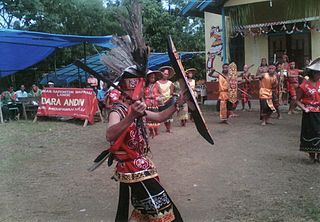
The Kendayan are an Indonesian ethnic group native to Kalimantan, Indonesia in Borneo. The population of the group is around 366,000.
Selakoa.k.a.Selakau, Salako or Silakau are the indigenous people native to the Selakau regions in Sambas Regency of West Kalimantan, Indonesia. Nowadays, the Selako diaspora can be found in the neighbouring Selakau regions as well; including the districts of Pemangkat, Paloh, Tebas, Teluk Keramat, Sejangkung, Sajingan Besar in Sambas Regency, the East Singkawang district in Singkawang, the districts of Tujuh Belas and Samalantan in Bengkayang Regency, and the Lundu district in Sarawak. Selako people are sometimes classified as part of larger Dayaks community, thus sometimes they are called as Selako Dayaks as well. Their native or indigenous language is the Selako language. Like any other indigenous Dayak groups, the Selako people embraced the Kaharingan religion, but many Selakos diaspora tend to have Christians and Roman Catholics faiths after the mass conversion by missionaries in the 19th century.
Aman may refer to:

Ma'anyan, Dayak Maanyan or Eastern Barito Dayak people are an ethnic group of the Dayak people indigenous to Borneo. They are also considered as part of the east Barito Dusun group with the name Dusun Ma'anyan. According to J. Mallinckrodt (1927), the Dusun people group is part of the Ot Danum people cluster, although later that theory was disproved by A. B. Hudson (1967), who argues that the Ma'anyan people are a branch of the Barito family. The Ma'anyan people who are often referred to as Dayak people are also referred to as Dayak Ma'anyan. The Dayak Ma'anyan people inhabit the east side of Central Kalimantan, especially in the East Barito Regency and parts of South Barito Regency which are grouped as Ma'anyan I. The Dayak Ma'anyan people also inhabit the northern parts of South Kalimantan, especially in Tabalong Regency which refers to the Dayak Warukin people. The Dayak Balangan people or Dusun Balangan people which are found in the Balangan Regency and the Dayak Samihim people that are found in the Kotabaru Regency are grouped together with the Dayak Ma'anyan people group. The Dayak Ma'anyan people in South Kalimantan are grouped as Ma'anyan II.

Rumah adat are traditional houses built in any of the vernacular architecture styles of Indonesia, collectively belonging to the Austronesian architecture. The traditional houses and settlements of the several hundreds ethnic groups of Indonesia are extremely varied and all have their own specific history. It is the Indonesian variants of the whole Austronesian architecture found all over places where Austronesian people inhabited from the Pacific to Madagascar each having their own history, culture and style.
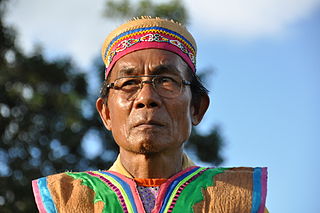
Ledjie Taq is the Kepala adat of the Wehea Dayak village of Nehas Liah Bing, East Kalimantan, Indonesia. He is known for his efforts to protect the Wehea Forest.
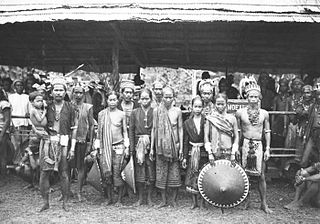
Mualang are an indigenous people of West Kalimantan from the Dayak group and a sub-ethnic of the Iban people. They speak the Mualang language and they are mostly concentrated in areas in the Sekadau Regency and Sintang Regency of West Kalimantan, Indonesia. The specific districts where the Mualang people live include:
- Belitang Hilir district, Sekadau
- Belitang district, Sekadau
- Belitang Hulu district, Sekadau
- Sepauk, Sintang and its surrounding region
Indigenous Peoples' Alliance of Nusantara is an Indonesian indigenous peoples' human rights and advocacy organization founded in 1999. AMAN has established 21 Regional Chapters (PW) and 114 Regional Chapters (PD) in 33 provinces. AMAN currently comprises 2,272 indigenous communities with an estimated population of over 15 million people.
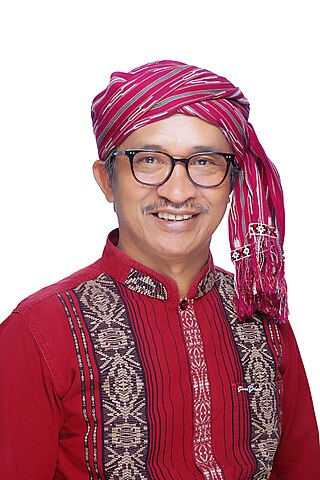
Nababan Abdon is the recipient of the 2017 Ramon Magsaysay Award and it was awarded for his courage and advocacy that have become the voice and face for the Indigenous Peoples Alliance in Indonesia.
Mandau Talawang Pancasila is a paramilitary organization, based mostly within the Indonesian provinces of Central Kalimantan and West Kalimantan.
Batamad, abbreviation from Barisan Pertahanan Masyarakat Adat Dayak, is an official paramilitary under National Dayak Customary Council in Indonesia. It was established in February 2012 with approval of Central Kalimantan provincial government based on Regional Law Number 16 of 2008. Initially, it was created as a response of rising religious extremism in Indonesia, including Central Kalimantan, and the paramilitary was tasked to supervise suspicious religious activities there, particularly those allegedly by Islamic extremism. Other than that, the organization is also tasked to enforce customary laws under Dayak culture, enforcing tribal land claims, as well as protecting rights of Dayak people. It is proposed in 2018 by Central Kalimantan province that the organization would also act as a security personnels during tribal courts. However, outside of its given legal authorities, the organization also participate in enforcing road traffic with Indonesian National Police. The organization has been descibred by local media as an "official tribal police".

Nusantara, officially the Capital City of Nusantara, is the future capital of Indonesia, scheduled to be inaugurated on 17 August 2024, coinciding with Indonesian Independence Day. Nusantara will replace Jakarta as the national capital, a position the latter city has held since the country's proclamation of independence in 1945.
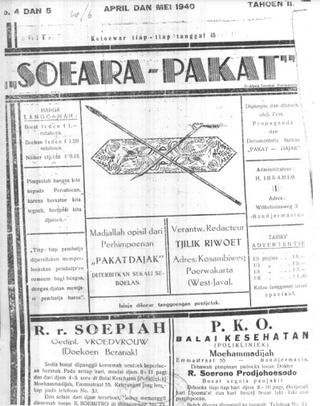
Dayak in politics refers to the participation of Dayaks to represent their political ideas and interests outside of their community. The movement has continued to have a profound impact on the development of Indonesia and Malaysia, especially in Kalimantan and Sarawak.
Delima Silalahi is an environmental activist from North Tapanuli, Indonesia, known for her efforts in safeguarding customary forests and Indigenous rights in North Sumatra. As the executive director of the NGO Kelompok Studi dan Pengembangan Prakarsa Masyarakat (KSPPM), she orchestrated efforts to reclaim over 17,000 acres of tropical forest that had been converted by a pulp and paper company.
References
- 1 2 3 "Central Governing Body Leadership". Aliansi Masyarakat Adat Nusantara. Aliansi Masyarakat Adat Nusantara. Archived from the original on 9 May 2015. Retrieved 31 March 2015.
- 1 2 Eshelman, Robert S. (November 3, 2014). "Indonesian government's concession policy prioritizes companies over forest communities". Mongabay. Retrieved 31 March 2015.
- 1 2 Offer, Christian (16 July 2006). "Kein Palmöl in den Tank!" (in German). Berlin, Germany: Regenwald Report. Retrieved 31 March 2015.
- ↑ Martone, Francesco (22 March 2010). "Press Release: Indigenous people, forests & climate". Forest & REDD. Retrieved 31 March 2015.
- ↑ Media, Tim (May 8, 2014). "Mina Setra Wakili Regio Kalimantan" (in Indonesian). Dewan Kehutanan Nasional. Retrieved 31 March 2015.
- ↑ "Mina Setra". Global Landscapes Forum. 2014. Retrieved 31 March 2015.
- ↑ "NSC DGM CONTACT LIST". DGM Indonesia. Retrieved 31 March 2015.